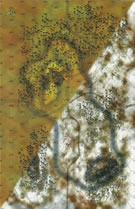|
Autumn Mist Elsenborn Revised #1 |
||
|---|---|---|
| (Attacker) Germany | vs | United States (Defender) |
| Formations Involved | ||
|---|---|---|
| Germany |  |
277th Infantry Division |
| United States |  |
99th "Battle Babies" Infantry Division |

|
| Overall Rating, 2 votes |
|---|
|
3.5
|
| Scenario Rank: --- of 957 |
| Parent Game | Elsenborn Revised |
|---|---|
| Historicity | Historical |
| Date | 1944-12-16 |
| Start Time | 06:00 |
| Turn Count | 16 |
| Visibility | Day & Night |
| Counters | 60 |
| Net Morale | 1 |
| Net Initiative | 1 |
| Maps | 1: 25 |
| Layout Dimensions | 43 x 28 cm 17 x 11 in |
| Play Bounty | 164 |
| AAR Bounty | 166 |
| Total Plays | 2 |
| Total AARs | 1 |
| Duplicates | ElsR001 |
| Battle Types |
|---|
| Inflict Enemy Casualties |
| Road Control |
| Rural Assault |
| Conditions |
|---|
| Entrenchments |
| Off-board Artillery |
| Reinforcements |
| Scenario Requirements & Playability | |
|---|---|
| Elsenborn Revised | Base Game |
| Introduction |
|---|
|
After a brief artillery bombardment, the Germans sent infantry divisions forward as the first wave of the attack known as Operation Herbstnebel, or Autumn Mist. These units would open the way through the American defenses for the panzer divisions to exploit deep into the Allied rear. At least that was the way it had been drawn up on Sixth SS Panzer Army's planning maps. |
| Conclusion |
|---|
|
Using searchlights directed at the low-hanging cloud cover, the Germans created what they called "artificial moonlight" to enhance visibility. It could not, however, enhance the willingness of the raw Volksgrenadiers to stand up to American firepower. The advance made some initial headway, forcing the 393rd Infantry Regiment's Company K to surrender and surrounding the rest of the regiment's 3rd Battalion. But the American defense rallied and the German attack stalled. |
| Additional Notes |
|---|
|
This scenario is completely playable using the maps and pieces from Battle of the Bulge 2: Elsenborn Ridge. |
| AFV Rules Pertaining to this Scenario's Order of Battle |
|---|
| 3 Errata Items | |
|---|---|

|
The reduced direct fire value of the Heer HMG became 5-5 starting with Fall of France. (plloyd1010
on 2015 Jul 31)
|

|
The morale and combat modifiers of German Sergeant #1614 should be "0", not "8". (Shad
on 2010 Dec 15)
|

|
The movement allowance on the counters in Airborne is misprinted. It should be "3." (rerathbun
on 2012 Jan 30)
|
| The Americans are tough in defending agianst assaults |
|---|
|
the Americans were set up on the high ground south of the main road with two entrenchments. On the southern side of the main road I placed a leader and two HMG, and one hex south of that another entrenched grouping ( 2 plt and a leader) to give support and to cut off a southern movement of German troops. Both US groups were on the 40m height. I placed one platoon on the main road at the 20m height line (dug in) aon a INF plt and the AT gun just behhind that below the 20m ridge line. I placed a PLT and Ldr in the area of the north east 40m hill top to act as a delaying distraction. The German plan was to run the majority straight down the main road and to run a south west supporting attack. The American delaying units failed early. The units in the 40m heights on the SW side of the map were made of sterner stuff and caused lots of damage. Both hexes were attacked with overwhelming German forces on two occasions and were repulsed with step losses and DM results. One two occasions German ARTY caused more damage to them than the Americans. On the other hand the Germans destroyed the Americans on the roads and cleared the route. At the end of the game the Germans had the road victory conditions, casualities ratio in their favor and the high ground VP for a decisive victory. The Germans had better leaders, better initiative rolls, a few fortunate rolls on combat and morale checks for them and not so much the Americans. Points to consider: American HMG in entrenchments are a real buzzsaw. German units need to close early and in mass if they are going to win. They must push on early and accept unit losses. Leader losses will stop the attack. |
| 0 Comments |

 DrRa010
DrRa010 


















